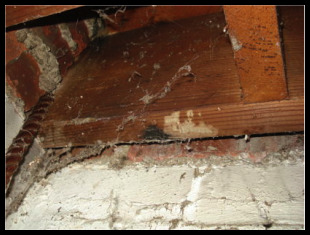Your home is your environment and addressing any unnecessary air leakage in a home is the most cost-effective way to reduce energy consumption and improve comfort.
This past weekend at WeatherizeDC's Weatherization Block Party, an energy auditor gave tours of the recently weatherized rectory that was celebrating a 36% decrease in unwanted air infiltration after the one-time $3,000-$4,000 weatherization investment, which resulted in a 20-25% decrease in energy use (and energy bills)!
A closer look:
Above is a photo taken before air-sealing measures were completed in the basement of St. Alban's rectory. The dust and spider webs were a give-away that chronic air leakage had been plaguing the space. The weatherization installers used 2-part foam to block up these cavities, which will help air leakage into the exterior walls and cut down on leakage all over the first floor! 
Above, Bobby and Wayne worked to dense-pack the attic floor with cellulose insulation, providing the maximum insulation possible as well as effective air-sealing.
Based on its size, every home has a recommended level of air leakage, known as the Building Airflow Standard that describes the minimum required air-leakage into a home to maintain safe indoor air quality. When an energy auditor visits your home at the beginning of your weatherization pathway, most homes measure 2 to 5 times as leaky as they should be after a blower door test.
Today, as you experiment with a reusable water battle, maybe an old bike in the garage, take a good look at the very common areas where your home is encouraging wasted energy. Weatherizing your home is equivalent to taking three cars off the road.
Clues for detecting air leakage around your home:
•Spider webs: Spiders are smart. They tend to build their webs in places where air flows by to increase their chances of catching insects. Look around in your basement and attic--see those dusty cobwebs? That's a spider telling you to weatherize you home.
•Dirty insulation: Anywhere that you have white, yellow or pink fiber-glass insulation in your home, poke around and see if you find any "graying" or dusty insulation. The graying insulation indicates places where air has been moving by this insulation for an extended amount of time, depositing dust as it moves through the fiber-glass.
•"Graying" carpet at the base of walls: Similar to the dirty insulation described above, this is due to air moving in through the spaces at the base of walls and past the carpet, where it deposits dust. Steam-cleanings won't solve it, but air-sealing will.
•Excessive dust: As air moves into your home, it often passes through the interiors of walls where it picks up a laundry-list of contaminants--dust, fiber-glass, mold, and all sorts of particulates. An overly dusty house is a good sign of a house that's asking for air-sealing.
•Icicles: Did you find ice build-up or icicles on your roof's edge during DC's snow storms this year? This is caused by melting snow due to a lack of insulation and air-sealing.
•Temperature Differences: Are there temperature differences between your first and second floor?
A few overall helpful numbers in thinking about how to best care for your first environment:
ENERGY SAVINGS (provided by the California Energy Commission)
Lightbulbs: 1%
Weatherstripping: 1%
Programmable thermostat: 3%
Swap air conditioner filers: 2%
Weatherization: 30%
Happy Earth Day! Let us know when you want to join the weatherization movement.